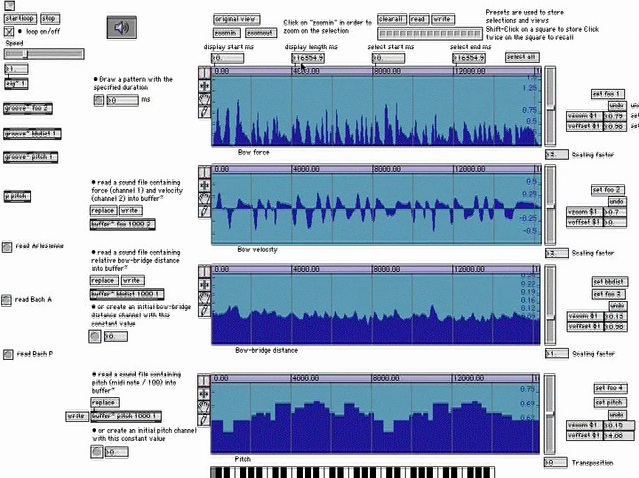Matthias Demoucron
Doctorant, Sound synthesis of bowed string instruments- Tel : 01 44 78 14 86
- Email :

These pages present some material related to my PhD work. You will find sounds, videos and illustrations that could not be included in the paper version. Feedbacks, remarks, suggestions, constructive critics and intellectual supports are welcome...
- Introduction
- PhD thesis: On the control of virtual violins - Physical modeling and control of bowed string instruments
- Measurements of bowing parameters in real performance
- Sound examples: control with real measurements and synthesized gestures
- Control interfaces: real time control with physical interfaces
Control with real measurements
Measurements of the bow force, bow velocity and bow-bridge distance during real performances can be used to control the bowed string model. Resulting synthesis are illustrated in the following videos. Example 1 shows for example how we can play with the scaling of the control parameters in order to obtain different sound qualities or how we can use isolated bow strokes as exemplary bowing patterns and modify them. Example 2 illustrates a slight modification of the performance obtained by slowing down or accelerating some parts of the performance.

Example 1: Arlesienne, Bizet Click on the picture to watch the movie |

Example 2: Allemanda, Bach Click on the picture to watch the movie |
Gesture models
From measurements recorded during real performances, it is possible to build some typical patterns related to technical bow strokes. Models that are deduced from these patterns aim at fitting the time evolution of the input parameters (mainly bow speed and bow pressure) with one or more analytical functions. These functions depend on a few parameters that can be changed in order to get different variations of the same class of bow strokes.Sautillé
Bouncing bow strokes like sautillé or spiccato are started from the hair and finish off the string. The string is excited during a rather short contact time, set by the rebound of the bow. The next examples illustrate sautillé models used to control the violin model. Three gesture parameters are changed in order to demonstrate their influence on the sound and the bow stroke quality: contact time (example 1), setting the time during which the string is excited by the rebound, force amplitude during the rebound (example 2), velocity amplitude of the to and fro motion of the bow (example 3).


Example 1 Example 2 Example 3 Staccato (or martelé)
The staccato is a fast, accented bow stroke that requires a good control of the bow for obtaining precise variations of the bow force during a rather short motion of the bow. It is characterised by an initial "pinching" of the string before the bow starts to move. "The pressure us then immediately lessened to the degree required. If this preparatory pressure is released to soon, there will not be an accent; if it is released too late, there will be a scratch." (Galamian)
The following examples illustrate a technical exercise (study no 7 by Kreutzer) performed with the staccato model and varying model parameters. In the first example, the amplitude of the force release is changed, which permits to obtain different staccato types: solid staccato, then flying staccato, then collé and finally solid staccato again. In the example 2, the initial pinching is changed in order to produce different accents and attack qualities. In the last example, the force at the instant of stopping is varied in order to illustrate scratchy sounds at the end of the stroke when the bow force is applied too early before the next stroke.


Example 1 Example 2 Example 3 Tremolo
Tremolo and fast détaché are rapid bowing patterns consisting of a quick to and fro motion of the bow with the bow on the string from the beginning. The following examples illustrate fast détaché simulated first with varying bow forces (example 1), showing different qualities for the sound, from a very light to a rather "harsh" and scratchy détaché. Then, example 2 shows a transition from fast détaché to sautillé by playing with the force release during each stroke and some parameters describing the control of the bow by the player. Finally, example 3 shows different accents obtained by changing the shape of the force during each stroke.


Example 1 Example 2 Example 3
